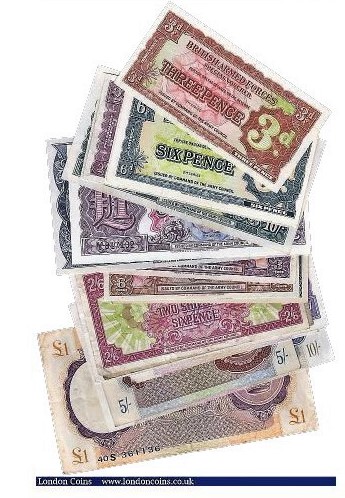British Armed Forces Special Vouchers

British Armed Forces Special Vouchers (Wikipedia)
At the end of the war in Europe in 1945, France, Britain, United States and Russia agreed at the Potsdam Conference to split Germany into four occupation zones. The British area was occupied by the 21st Army Group that was collectively known as the British Army of the Rhine (BAOR). The Allies' job was challenging. They had to disband and disarm the German fighting machine, reassemble the country's basic infrastructure, and cope with population on the brink of starvation. To this end the BAOR operated as a country within a country, requiring a monetary system that functioned to serve the needs of the occupying forces. However, a problem soon emerged; goods intended for the troops were being sold to a thriving black market among the local population at highly inflated prices. Millions of pounds sterling were being lost by the taxpayers of Britain. A series of stopgap measures slowed, but did not stop the problem. It was decided in March 1946 that special military voucher system was needed.
The British Armed Forces issued their own banknotes between 1946 and 1972.
Since 2003, they have issued their own small change tokens for use in Iraq and Afghanistan, nicknamed pogs by the Squaddies, after the children's game popular in the early 1990s.
Historically, soldiers serving overseas had been paid in local currency rather than in their "home" currency, most cash drawn by soldiers would go directly into the local economy, and in a damaged economy the effects of a hard currency such as the £ circulating freely alongside weaker local currencies could be severely problematic, risking severe inflation. There were other problems as well; once £ were circulating in a combat region, the opposing side could freely use its own stocks of £ as currency, or acquire stocks for use elsewhere to support their war effort. The high purchasing power of the £ and its easy transference back to Britain also posed a significant incentive to the black marketers.
However, whilst the use of local currencies was effective where they were provided in cooperation with the local authorities, it was impractical in combat zones where the government might be either hostile, deliberately ambivalent, or simply non-existent. In these cases, the military authorities issued special "military currency", which was paid out to soldiers at a fixed rate of exchange and simply declared legal tender in occupied areas by local commanders.
After a remarkably brief period of preparation, the first series of 52,400,000 British Armed Forces Special Vouchers (BAFSV), valued at just over 10 million pounds sterling were printed by Thomas De La Rue and officially issued on August 1, 1946. In due course the ingenuity of the local population and the troops largely circumvented the intention of the first issue BAFSV's to slow black market activities. By mid 1947 it was decided, under a cloak of secrecy, to prepare a new issue to replace the first, then immediately demonetize the first to limit the conversion of illicitly-gained first series vouchers. This scheme was carried out on January 6, 1948, when the second issue was released.
The third series was printed in 1948 by J. Waddington Ltd, but were not issued until 1956 for use during the Suez Canal Crisis. This situation was quickly resolved over a two-month period and those notes withdrawn.
The fourth issue was originally discussed in 1952 but were not ordered until the heating up of the cold war and the lack of a backup series prompted the British War Office in 1962 to design not only a fourth, but also a fifth series.
A new printer, Bradbury Wilkinson, was chosen for the job of producing these next two series: The fourth series was printed, but never issued, and according to all records, the fifth series was never printed. The sixth series, together with the 1 and 5 pound notes of the second series, were used in Berlin up to December 31, 1979, when they were finally withdrawn. On February 14, 1991, The Ministry of Defence auctioned off their stock of 17 million uncirculated vouchers from the 2nd, 3rd, 4th and 6th series to a consortium of dealers.